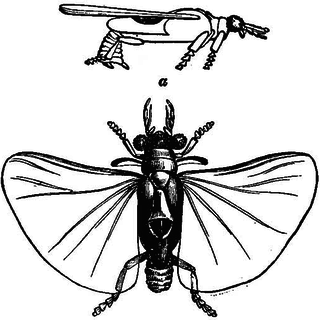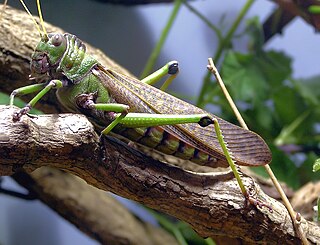
The family Gryllidae contains the subfamilies and genera which entomologists now term true crickets. They belong to the Orthopteran subfamily Ensifera, having long, whip-like antennae and has been reduced in terms of the older literature, with taxa such as the spider-crickets and allies, sword-tail crickets, wood or ground crickets and scaly crickets elevated to family level. The type genus is Gryllus and the first use of the family name "Gryllidae" was by Walker.

The Caelifera are a suborder of orthopteran insects. They include the grasshoppers and grasshopper-like insects, as well as other superfamilies classified with them: the ground-hoppers (Tetrigoidea) and pygmy mole crickets (Tridactyloidea). The latter should not be confused with the mole crickets (Gryllotalpidae), which belong to the other Orthopteran sub-order Ensifera.

Stylopidae is a family of twisted-winged insects in the order Strepsiptera. There are about 15 genera and more than 330 described species in Stylopidae.

The Romaleidae or lubber grasshoppers are a family of grasshoppers, based on the type genus Romalea. The species in this family can be found in the Americas.

Grylloidea is the superfamily of insects, in the order Orthoptera, known as crickets. It includes the "true crickets", scaly crickets, wood crickets and other families, some only known from fossils.

The Cyrtacanthacridinae are a subfamily of Orthoptera: Caelifera in the family Acrididae. They are sometimes referred-to as bird locusts, criquets voyageurs in French-speaking Africa, and Knarrschrecken in German.
Pamphagodidae is a small family of grasshoppers in the Orthoptera: suborder Caelifera. Species in this family can be found in southern Africa and Morocco.

The superfamily Hagloidea are insects belonging to the order Orthoptera: Ensifera; they are now represented by the extant Prophalangopsidae, with many extinct genera and families.

Episactidae is a family of grasshoppers in the order Orthoptera. There are about 19 genera and more than 60 described species in Episactidae, found in Central and South America, China, and Madagascar.
Mastacideidae is a family of grasshoppers in the order Orthoptera. There are at least two genera and about eight described species in Mastacideidae, found in South Asia.
Eolocustopsidae is an extinct family of grasshoppers in the order Orthoptera. There are at least two genera and two described species in Eolocustopsidae.
Locustavidae is an extinct family of grasshoppers in the order Orthoptera. There are about 6 genera and 12 described species in Locustavidae, with fossils found in Australia, China, Kyrgyzstan, and Russia.
Locustopsidae is an extinct family of grasshoppers in the order Orthoptera. There are about 17 genera and more than 60 described species in Locustopsidae.
Protogryllidae is an extinct family of crickets in the order Orthoptera. There are about 8 genera and more than 20 described species in Protogryllidae.
Regiatidae is an extinct family of grasshoppers in the order Orthoptera. There are at least three genera and four described species in Regiatidae.
Tcholmanvissiidae is an extinct family of Orthoptera. There are at least two genera and about eight described species in Tcholmanvissiidae.
Tettoedischiidae is an extinct family of Orthoptera. There are at least two genera and two described species in Tettoedischiidae.
Thueringoedischiidae is an extinct family of long-horned Orthoptera. There are at least three genera and three described species in Thueringoedischiidae.
Xyronotidae is a family of central American grasshoppers in the order Orthoptera. There are at least two genera and four described species in Xyronotidae.

Wētā is the common name for a group of about 70 insect species in the families Anostostomatidae and Rhaphidophoridae, endemic to New Zealand. They are giant flightless crickets, and some are among the heaviest insects in the world. Generally nocturnal, most small species are carnivores and scavengers while the larger species are herbivorous. Wētā are preyed on by introduced mammals, and some species are now critically endangered.








